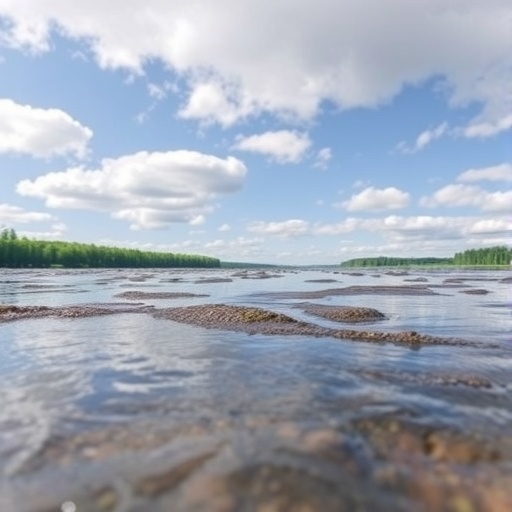In an era marked by unprecedented environmental challenges, the need to critically evaluate and monitor the health of natural water bodies has never been more pressing. Recent research conducted by a group of scientists has shed light on river water quality dynamics in the Klang River Basin, Malaysia. Their findings not only highlight the historical water quality trends but also illustrate the significant shifts occasioned by the COVID-19 pandemic. This research employs advanced functional data analysis techniques to probe into spatio-temporal patterns of water quality, providing an invaluable resource for policymakers and environmentalists alike.
Inspiration for this study stems from the growing acknowledgment of the impact of anthropogenic activities on aquatic ecosystems. Malaysia’s Klang River is a vital water source, serving both ecological functions and human needs. However, it has been subjected to various stressors, including urbanization, industrial discharge, and agricultural runoff. Compounded by the global pandemic, which inadvertently altered human behavior and industrial patterns, there was an urgent need to understand how these dynamics influenced water quality.
The research team undertook a comprehensive assessment encompassing multiple monitoring stations along the Klang River. They collected extensive water quality datasets, measuring variables such as pH, dissolved oxygen, turbidity, and nutrient concentrations. By employing functional data analysis, the researchers could skillfully interpret the temporal patterns in water quality indicators, unveiling trends that were not readily discernible through conventional statistical methods.
One of the most fascinating findings of the study is the marked shift in water quality parameters pre- and post-pandemic. The lockdown measures enforced during the height of the COVID-19 pandemic led to a significant decrease in pollution levels, primarily attributed to reduced vehicular traffic and industrial activities. This temporary reprieve facilitated a momentary recovery of the river ecosystem, illustrating the potential benefits of human inactivity on water bodies.
Additionally, the analysis revealed that specific regions of the Klang River showed differing responses to the pandemic’s impacts. Areas closest to urban centers experienced more significant fluctuations in water quality, indicating that urbanization exacerbates vulnerability. Conversely, more remote sections of the river exhibited a level of resilience, although this is subject to the extent of natural buffering afforded by surrounding ecosystems.
Interestingly, the study also highlights the potential for long-term monitoring infrastructure to yield critical insights into environmental changes. The use of sophisticated data collection techniques—including in-situ sensors and remote sensing technologies—allowed for real-time insights into water quality. This is paramount for effectively managing water resources, particularly in light of climate change and urban expansion.
Furthermore, the researchers draw attention to the socio-economic implications of their findings. As water quality directly affects public health and local economies, understanding its fluctuations is crucial for empowering communities. The research underscores the necessity for community engagement and awareness regarding water quality issues, ensuring that citizens remain informed about the state of their natural resources.
Importantly, the authors advocate for integrating findings into policymaking processes. Effective environmental governance must rely on robust data. The study’s insights can inform targeted interventions at both regional and national levels, potentially leading to the formulation of stricter regulations regarding pollutants entering the river system. Within a governance framework, these insights could play a critical role in promoting sustainable industrial practices and advocating for community-driven conservation efforts.
Although the implications of this research are promising, it does not shy away from addressing challenges that remain. The aftereffects of the pandemic on human behavior may lead to a resurgence in pollution levels as industries ramp up production post-lockdown. This reinforces the imperative need for ongoing monitoring to gauge the efficacy of environmental regulations and community initiatives.
This research emphasizes that while the temporary improvements in water quality during the pandemic were encouraging, without sustained efforts, these gains may be ephemeral. The authors highlight the significance of fostering a culture of environmental stewardship where both private and public sectors collaborate to safeguard water resources. Advocating for sustainability in manufacturing processes, promoting pollution reduction technologies, and investing in community education are pivotal elements in this endeavor.
Moreover, the research showcases a valuable methodology for future environmental studies. Functional data analysis can serve as a useful tool in other contexts, allowing researchers to analyze complex datasets with multiple variables effectively. As environmental issues grow increasingly multifaceted, robust statistical frameworks will be essential in untangling and understanding these intricacies.
In conclusion, the findings from the Klang River study present a crucial dialogue about river health amidst a backdrop of global challenges. As the world grapples with the long-term implications of the pandemic, insights such as these serve as a beacon for understanding the interplay between human activity and natural ecosystems. There is a clear need for ongoing research, reinforced by rigorous data collection and analysis, to ensure that the trajectories of water quality are more favorable in the future.
As researchers continue to explore the ramifications of anthropogenic actions on water bodies, their work can guide the development of effective conservation strategies. The study of Klang River’s water quality is but one of many such initiatives, and the call for robust ongoing engagement with our natural resources is louder than ever. For those invested in environmental health, this research serves as a reminder that every action counts in the quest to preserve our precious water resources.
Subject of Research: Spatio-temporal patterns of river water quality in the Klang River Basin, Malaysia.
Article Title: Spatio-temporal patterns of river water quality in the Klang River Basin, Malaysia: a functional data analysis approach to detect pre- and post-pandemic shifts.
Article References:
Ali, N.F.M., Mohamed, I., Yunus, R.M. et al. Spatio-temporal patterns of river water quality in the Klang River Basin, Malaysia: a functional data analysis approach to detect pre- and post-pandemic shifts.
Environ Monit Assess 197, 1198 (2025). https://doi.org/10.1007/s10661-025-14644-9
Image Credits: AI Generated
DOI:
Keywords: River water quality, Klang River Basin, functional data analysis, COVID-19 pandemic, spatio-temporal patterns, environmental monitoring.




